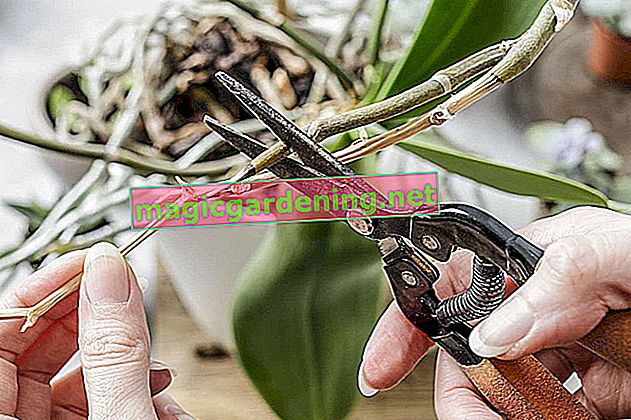
Distinguishing sick from healthy roots - this is how it works
In view of their vital functions, it is obvious that healthy orchid roots should not be severed. An exception applies if the root strands are sick, rotten or dead. Diagnosing this condition with certainty is not always easy. On their surface, aerial roots have an absorption fabric made of air-filled tissue cells that appear white or cream-colored when dry and are still fully functional.
also read
- Handle aerial roots properly when repotting orchids
- Caring for the butterfly orchid in an exemplary manner - how to do it right
- Here's the right way to combat mold on orchids
As long as an orchid root is lush and green, there is no doubt about its health. If you notice silvery-white, dry roots, a moisture test will provide information about the actual condition. Spray these aerial roots with lime-free water. If they don't turn green within a few minutes, you can cut off the roots. You can immediately cut off all orchid roots that are mushy, putrid-brown or covered with black spots.
Instructions for root pruning on epiphytic orchids
If you have found sick or rotten roots on an orchid, you need to act immediately to prevent the pathogens from spreading further. If the strands are dried out due to a lack of water, wait until the next repotting date to cut them back. Have a freshly sharpened knife, scalpel or scissors ready and a disinfectant. How to do it right:
- Pot the orchid and shake off the substrate
- Fix the affected aerial root with one hand and take the cutting tool in the other hand
- At roots with black spots, cut off the diseased tissue in stages from the tip
- Meticulously disinfect the blade between each cut to avoid transferring bacteria into healthy tissue
The pruning is finished when only lush green tissue is left on all aerial roots. Ideally, you should now take a new culture pot to hand in order to plant the orchid in fresh substrate. If you would like to use the previous vessel, it will be thoroughly cleaned and disinfected.
Tips
If numerous aerial roots protrude beyond the edge of the pot, the cramped orchid would like a larger cultivation pot. Please choose an appointment after the flowering time to repot the orchid. Immersed in soft, lukewarm water for a few minutes will make even the most stubborn root strands pliable.







